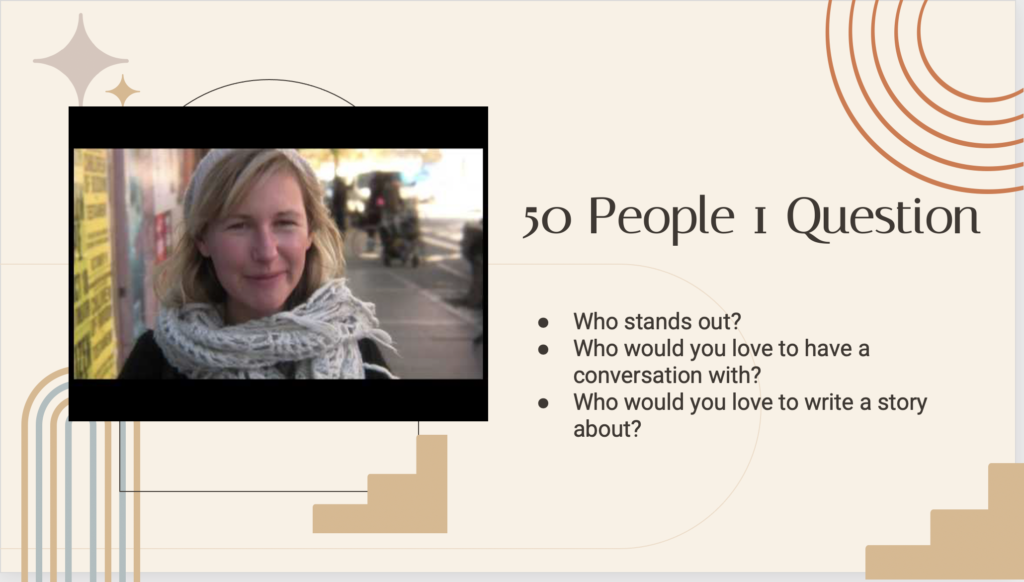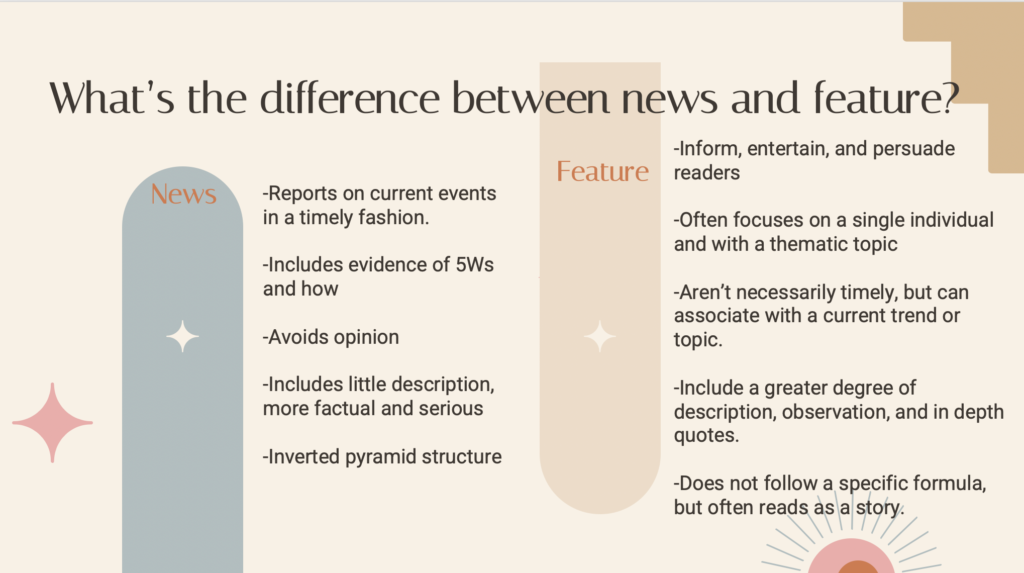One of my favorite units to teach in journalism is feature writing. Sometimes it is so hard for kids to bring color and life to their stories, but when we really look at descriptive writing through the lens of feature writing, students can create such a powerful pieces.
I start with the idea that everyone has a story. Using the classic 50 people one question video to engage kids in the idea that even asking one simple question can elicit a variety of different answers. There are so many different variations of this series, but I think the Brooklyn video is a great introduction to this concept and really engages great discussion. By just showing this five minute video clip, it’s fascinating to hear from students when you ask the question: “Who would you most like to have a conversation with?” Or, “Which of these answers do you think could turn into a full story?” There is so much variety in their responses and it helps reinforce the idea that everyone has a story to tell.
I also use the Pulitzer Prize winning piece The Boy Behind the Mask by Tom Hallman to introduce students to an in-depth feature writing. If you haven’t read this moving piece yet, you must check this out. This story includes all forms of narrative story telling and story modes.


One way I help students differentiate between a news story and a feature story as my pointing out the following key elements:
1. A good feature story will inform, entertain, and persuade readers.
2. A feature story often focuses on the single individual with a thematic topic.
3. A feature story isn’t necessarily time worthy or newsworthy, but it does focus on a current trend topic or issue.
4. A feature story will include a greater degree of description, observation. It will include strong quotes.
5. A feature doesn’t necessarily follow the traditional news formula, but it often reads as a story.
In Depth feature: This type of feature story includes in-depth research and observation that a journalist can cover over a longer period of time.
Personality sketch: Often written about a specific individual who has something interesting to express. It will include an overview about the individual, their personality, habits, and what makes them unique.
Live in color: This type of feature provides an overview of “behind the scenes” of an individual‘s life, issue, or experience.
Flashback or flash forward: This type of story aims to commemorate or remember a notable figure and can highlight a special anniversary or mile stone.
Personal experience: this reads like a small personal narrative includes a lot of description and imagery.
Theme: Every story should be about some thing specifically. That something is the theme. It helps readers understand that “so what” and “is that all there is”.
Research: Research in your feature story should do any of the following:
Quotes and details: When we build our feature story there are four key elements around quotes and details we should remember:
Description observation: Through direct observation through a journalist can use figurative language to re-create scenes or build sensation. The writer should use descriptive “show” language through any of the following devices:
Story angle and purpose: Every good feature has a narrow specific and focused theme to provide a clear purpose.
Organization: Feature stories are generally organized using a champagne or “martini glass “structure this generally reads like a narrative story with a loose structure.
Use a variety of different story modes:
Organize the story:
•Hardhead (circle, square, circle, square)
•Champagne glass: narrow focus
•Literary diagram: reads like a story
Story Contents:
Descriptive Lead: Should grab the reader’s attention and fit the mood of the story. Should include description (attention to 5 senses and observation).
Nutgraph: Expand beyond the exposition in the lead and provide additional background on the characters, setting, and theme
Body Paragraphs:
•Introduce the key issue or conflict that will propel the story forward
•Build action and sequence events using facts, detail, and quotes
Conclusion: Bring the story to a close by circling back and closing up your opening. The end is the last thing your reader reads and remembers. It should be as strong as the lead.
Should pull the story to a close—could do this by:
Photo credit Unsplash by Aaron Burden